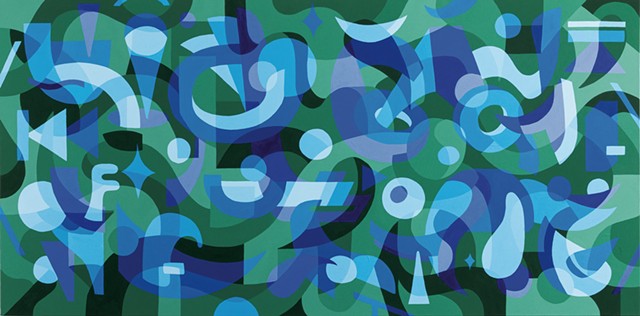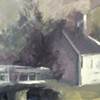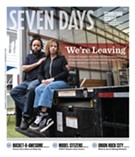click to enlarge 
- Courtesy
- "Saw a Blue Bird on the Bike Path"
Will Gebhard knows what catches the eye. At his first gallery show — "So It Goes," at Soapbox Arts in Burlington — overlapping curvy and geometric shapes in rich colors or grisaille fill canvases, glass vases, plywood cutouts and a vinyl record sleeve to their edges. Methodically distributed across surfaces, Gebhard's distinct shapes and bold colors hold a viewer's gaze until they merge into figures — or seem to.
Gebhard's mural outside the gallery, on the back wall of Kerry's Kwik Stop, may prompt a gallerygoer to expect abstract figuration. "Dreaming of Owning a Daybed," commissioned for the 2019 South End Art Hop, shows a stylized figure composed of red, yellow, black and white shapes lying in the grass, knees propped and arms in the air. The background is sky blue.
But Gebhard's newer works inside Soapbox often leave the viewer more to guess about. "Balancing Act," a plywood cutout, quickly resolves from a puzzle of shapes into a figure reading a book beside a lamp. "Separation Anxiety," meanwhile, only hints at a hidden figure (or perhaps two) among its densely layered red, orange and yellow shapes woven into green ones.
Gebhard, who just turned 30, takes his visual cues from the world of graphic design. After studying the discipline at Champlain College, he joined Sticky Brand, a Burlington producer of promotional goods run by Nicolas Dagostino and Dave Mullin.
click to enlarge 
Gebhard sold his art at Steak Frites, a series of pop-up affordable art fairs held at Signal Kitchen and organized by Gebhard, Dagostino, Mullin, John Moore and Signal Kitchen's Alex Lalli and Matt Palmieri. He has also designed beer cans for Foam Brewers and painted public walls with fellow muralist Mary Lacy, whom Soapbox also represents.
During a phone call, Gebhard traced his use of precisely painted abstract shapes to a graphic artist's tool familiar from his work: the divide function of the Pathfinder tool in Adobe Illustrator.
"You can take shapes and divide them," he explained. "[For example,] the Venn diagram becomes three different shapes" — an almond and two crescents.
Among his art-historical influences, Gebhard cites Stuart Davis, a midcentury American painter with a flat, graphic style; and Henry Moore, the British sculptor whose abstract figures combine undulating forms and voids.
In developing his own vocabulary of shapes, Gebhard said, lately he has become "more confident directly articulating a subject in pieces. I can render and address the subject while also obscuring it."
click to enlarge 
He achieves that obscurity partly through shades of color. Gebhard previously used Bauhausian primary colors of red, yellow and blue, plus white and black, all straight out of the tube. He set his subjects against a solid background within the limits of the canvas.
His recent work transforms the solid background into competing shapes in an array of color gradations that appear to layer over and under the dominant shapes. The method complicates notions of foreground and background.
In "She Didn't Name Either of the Cats," for instance, discrete, almost-3D shapes in reds, oranges and yellows — a witch's hat and broom among them — pop against deep-blue swirls in at least four hues. Yet the latter seem simultaneously to cast shadows on the warmly colored shapes, darkening their shades where they appear overlaid.
Similarly, "Saw a Bluebird on the Bike Path" overlays an interlocking pattern of biomorphic shapes in blue tones on green swirls and swooshes that also appear to be applied on top.
"Separation Anxiety" is the largest of the paintings, at 62 by 98 inches, and the most complex in its weaving of shapes. As the title suggests, it challenges the eye to separate the red-orange-toned figure from its green-toned background. It's difficult.
Shades of black characterize a number of works. "A Formal Vase," one of two acrylic-painted glass vases, is patterned with black and gray shapes that might be projecting or receding. Four small canvases, titled "Straight to Voicemail Nos. 1-4," suggest the absence of a human presence both in their titles and in their flat, interwoven black-and-gray shapes.
click to enlarge 
- Courtesy
- "Separation Anxiety"
While those works are entirely abstract, "A Bump in the Dark," painted on a vintage record sleeve, suggests a gray-toned figure who takes surrealist form against a black background. There may also be a beer can in the lower left corner.
"Walking Through Tall Grass With an Iron Deficiency" might keep viewers guessing the longest. An apparent figure in gray, its constituent shapes highlighted with thin lines of color, stalks the black background like a futurist machine. But the painting could also simply be a dynamic arrangement of forms.
Gebhard provides a wide-ranging explanation of his show in an artist statement, including a somewhat overwrought reference to "the infinite beauty of existence and its relentless absurdity. In the so-called shadow of the ever-nearing end." He notes that the show's title comes from a line in Kurt Vonnegut's anti-war novel Slaughterhouse-Five, in which "So it goes" is a response to casualties.
But what stands out in Gebhard's statement is a description of his style: "the ebb and flow of shape and color." With his exacting manipulation of those two elements, the artist successfully communicates what Soapbox owner Patricia Trafton calls his "visual breakdown of the world."























































